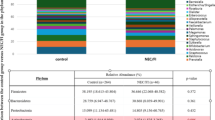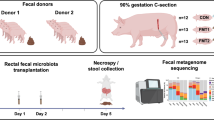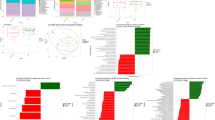Abstract
Introduction:
Necrotizing enterocolitis (NEC) is a devastating disease of premature infants. Probiotics decrease the risk of NEC in clinical and experimental studies. Antimicrobial peptides protect the gut against noxious microbes and shape the commensal microbiota, but their role in NEC remains unclear.
Methods:
To investigate the expression of antimicrobial peptides in experimental NEC and the impact of probiotics on their expression, premature rats were divided into three groups: dam fed (DF), hand fed with formula (FF), or hand fed with formula containing Bifidobacterium bifidum (FF + BIF). All groups were exposed to asphyxia and cold stress.
Results:
Like in human ontogeny, the rat pup has low expression of Paneth cell antimicrobials, which increases rapidly during normal development. The expression of lysozyme, secretory phospholipase A2 (sPLA2), pancreatic-associated proteins 1 and 3 mRNA was elevated in the FF group with a high incidence of NEC, as compared with the DF and FF + BIF groups where the disease was attenuated.
Discussion:
We conclude that induction of antimicrobial peptides occurs in experimental NEC similar to that reported in human disease and is attenuated when disease is averted by probiotic B. bifidum. The induction of antimicrobial peptides is likely an adaptive mucosal response that is often not sufficient to prevent disease in the premature gut.
Similar content being viewed by others
Log in or create a free account to read this content
Gain free access to this article, as well as selected content from this journal and more on nature.com
or
References
Eichenwald EC, Stark AR . Management and outcomes of very low birth weight. N Engl J Med 2008;358:1700–11.
Henry MC, Moss RL . Necrotizing enterocolitis. Annu Rev Med 2009;60:111–24.
Neu J, Walker WA . Necrotizing enterocolitis. N Engl J Med 2011;364:255–64.
Morowitz MJ, Poroyko V, Caplan M, Alverdy J, Liu DC . Redefining the role of intestinal microbes in the pathogenesis of necrotizing enterocolitis. Pediatrics 2010;125:777–85.
Guthmann F, Kluthe C, Bührer C . Probiotics for prevention of necrotising enterocolitis: an updated meta-analysis. Klin Padiatr 2010;222:284–90.
Caplan MS, Miller-Catchpole R, Kaup S, et al. Bifidobacterial supplementation reduces the incidence of necrotizing enterocolitis in a neonatal rat model. Gastroenterology 1999;117:577–83.
Khailova L, Dvorak K, Arganbright KM, et al. Bifidobacterium bifidum improves intestinal integrity in a rat model of necrotizing enterocolitis. Am J Physiol Gastrointest Liver Physiol 2009;297:G940–9.
Khailova L, Mount Patrick SK, Arganbright KM, Halpern MD, Kinouchi T, Dvorak B . Bifidobacterium bifidum reduces apoptosis in the intestinal epithelium in necrotizing enterocolitis. Am J Physiol Gastrointest Liver Physiol 2010;299:G1118–27.
Bevins CL, Salzman NH . Paneth cells, antimicrobial peptides and maintenance of intestinal homeostasis. Nat Rev Microbiol 2011;9:356–68.
Salzman NH, Underwood MA, Bevins CL . Paneth cells, defensins, and the commensal microbiota: a hypothesis on intimate interplay at the intestinal mucosa. Semin Immunol 2007;19:70–83.
Mallow EB, Harris A, Salzman N, et al. Human enteric defensins. Gene structure and developmental expression. J Biol Chem 1996;271:4038–45.
Salzman NH, Polin RA, Harris MC, et al. Enteric defensin expression in necrotizing enterocolitis. Pediatr Res 1998;44:20–6.
Coutinho HB, da Mota HC, Coutinho VB, et al. Absence of lysozyme (muramidase) in the intestinal Paneth cells of newborn infants with necrotising enterocolitis. J Clin Pathol 1998;51:512–14.
Puiman PJ, Burger-Van Paassen N, Schaart MW, et al. Paneth cell hyperplasia and metaplasia in necrotizing enterocolitis. Pediatr Res 2011;69:217–23.
Termén S, Tollin M, Olsson B, Svenberg T, Agerberth B, Gudmundsson GH . Phylogeny, processing and expression of the rat cathelicidin rCRAMP: a model for innate antimicrobial peptides. Cell Mol Life Sci 2003;60:536–49.
Jia HP, Mills JN, Barahmand-Pour F, et al. Molecular cloning and characterization of rat genes encoding homologues of human β-defensins. Infect Immun 1999;67:4827–33.
Cash HL, Whitham CV, Behrendt CL, Hooper LV . Symbiotic bacteria direct expression of an intestinal bactericidal lectin. Science 2006;313:1126–30.
Iovanna JL, Keim V, Bosshard A, et al. PAP, a pancreatic secretory protein induced during acute pancreatitis, is expressed in rat intestine. Am J Physiol 1993;265:G611–8.
Sharma R, Tepas JJ 3rd. Microecology, intestinal epithelial barrier and necrotizing enterocolitis. Pediatr Surg Int 2010;26:11–21.
Szajewska H . Probiotics and prebiotics in preterm infants: where are we? Where are we going? Early Hum Dev 2010;86 Suppl 1:81–6.
Sherman MP . New concepts of microbial translocation in the neonatal intestine: mechanisms and prevention. Clin Perinatol 2010;37:565–79.
Fernandez MI, Regnault B, Mulet C, et al. Maturation of paneth cells induces the refractory state of newborn mice to Shigella infection. J Immunol 2008;180:4924–30.
Ménard S, Förster V, Lotz M, et al. Developmental switch of intestinal antimicrobial peptide expression. J Exp Med 2008;205:183–93.
Bry L, Falk P, Huttner K, Ouellette A, Midtvedt T, Gordon JI . Paneth cell differentiation in the developing intestine of normal and transgenic mice. Proc Natl Acad Sci USA 1994;91:10335–9.
Mukherjee S, Vaishnava S, Hooper LV . Multi-layered regulation of intestinal antimicrobial defense. Cell Mol Life Sci 2008;65:3019–27.
Putsep K, Axelsson LG, Boman A, et al. Germ-free and colonized mice generate the same products from enteric prodefensins. J Biol Chem 2000;275:40478–82.
DiGiulio DB, Romero R, Kusanovic JP, et al. Prevalence and diversity of microbes in the amniotic fluid, the fetal inflammatory response, and pregnancy outcome in women with preterm pre-labor rupture of membranes. Am J Reprod Immunol 2010;64:38–57.
Underwood MA, Gilbert WM, Sherman MP . Amniotic fluid: not just fetal urine anymore. J Perinatol 2005;25:341–8.
Schröder JM, Harder J . Human β-defensin-2. Int J Biochem Cell Biol 1999;31:645–51.
Ciccia F, Bombardieri M, Rizzo A, et al. Over-expression of paneth cell-derived anti-microbial peptides in the gut of patients with ankylosing spondylitis and subclinical intestinal inflammation. Rheumatology (Oxford) 2010;49:2076–83.
Jäger S, Stange EF, Wehkamp J . Antimicrobial peptides in gastrointestinal inflammation. Int J Inflam 2010;2010:910283.
Bevins CL, Stange EF, Wehkamp J . Decreased Paneth cell defensin expression in ileal Crohn’s disease is independent of inflammation, but linked to the NOD2 1007fs genotype. Gut 2009;58:882–3;discussion 883.
Schlee M, Harder J, Köten B, Stange EF, Wehkamp J, Fellermann K . Probiotic lactobacilli and VSL#3 induce enterocyte β-defensin 2. Clin Exp Immunol 2008;151:528–35.
Amit-Romach E, Uni Z, Reifen R . Multistep mechanism of probiotic bacterium, the effect on innate immune system. Mol Nutr Food Res 2010;54:277–84.
Möndel M, Schroeder BO, Zimmermann K, et al. Probiotic E. coli treatment mediates antimicrobial human β-defensin synthesis and fecal excretion in humans. Mucosal Immunol 2009;2:166–72.
Chirgwin JM, Przybyla AE, MacDonald RJ, Rutter WJ . Isolation of biologically active ribonucleic acid from sources enriched in ribonuclease. Biochemistry 1979;18:5294–9.
Clark JA, Doelle SM, Halpern MD, et al. Intestinal barrier failure during experimental necrotizing enterocolitis: protective effect of EGF treatment. Am J Physiol Gastrointest Liver Physiol 2006;291:G938–49.
Bustin SA . Absolute quantification of mRNA using real-time reverse transcription polymerase chain reaction assays. J Mol Endocrinol 2000;25:169–93.
Wehkamp J, Chu H, Shen B, et al. Paneth cell antimicrobial peptides: topographical distribution and quantification in human gastrointestinal tissues. FEBS Lett 2006;580:5344–50.
Dvorak B, Halpern MD, Holubec H, et al. Epidermal growth factor reduces the development of necrotizing enterocolitis in a neonatal rat model. Am J Physiol Gastrointest Liver Physiol 2002;282:G156–64.
Moore KS, Bevins CL, Tomassini N, et al. A novel peptide-producing cell in Xenopus: multinucleated gastric mucosal cell strikingly similar to the granular gland of the skin. J Histochem Cytochem 1992;40:367–78.
Author information
Authors and Affiliations
Corresponding author
Rights and permissions
About this article
Cite this article
Underwood, M., Kananurak, A., Coursodon, C. et al. Bifidobacterium bifidum in a rat model of necrotizing enterocolitis: antimicrobial peptide and protein responses. Pediatr Res 71, 546–551 (2012). https://doi.org/10.1038/pr.2012.11
Received:
Accepted:
Published:
Issue date:
DOI: https://doi.org/10.1038/pr.2012.11
This article is cited by
-
Increased expression of OLFM4 and lysozyme during necrotizing enterocolitis in neonates: an observational research study
BMC Pediatrics (2022)
-
Effects of probiotics on experimental necrotizing enterocolitis: a systematic review and meta-analysis
Pediatric Research (2018)
-
Bifidobacterium longum subsp. infantis in experimental necrotizing enterocolitis: alterations in inflammation, innate immune response, and the microbiota
Pediatric Research (2014)
-
Human β-defensin-3 promotes intestinal epithelial cell migration and reduces the development of necrotizing enterocolitis in a neonatal rat model
Pediatric Research (2014)
-
Bifidobacteria: their impact on gut microbiota composition and their applications as probiotics in infants
Applied Microbiology and Biotechnology (2014)



